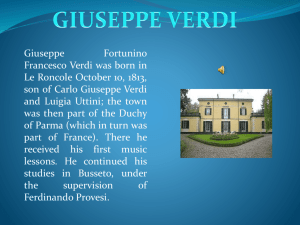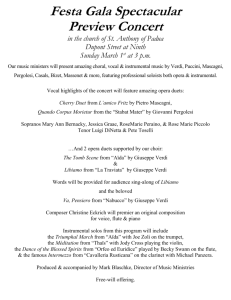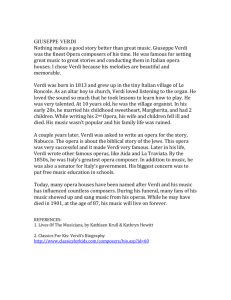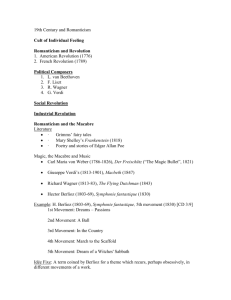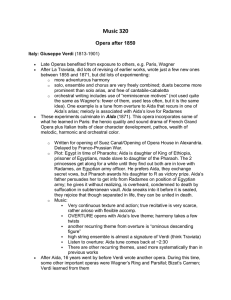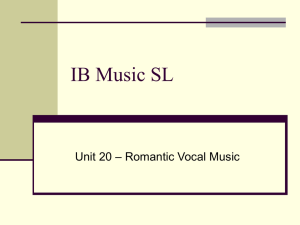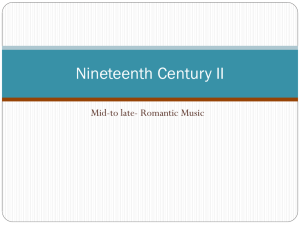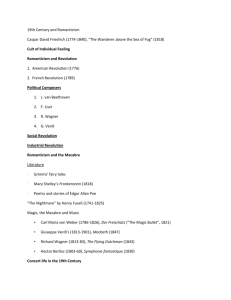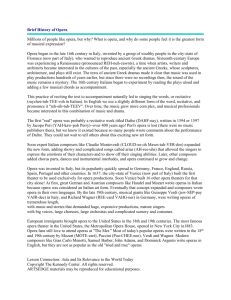Music History IV: Dr
advertisement
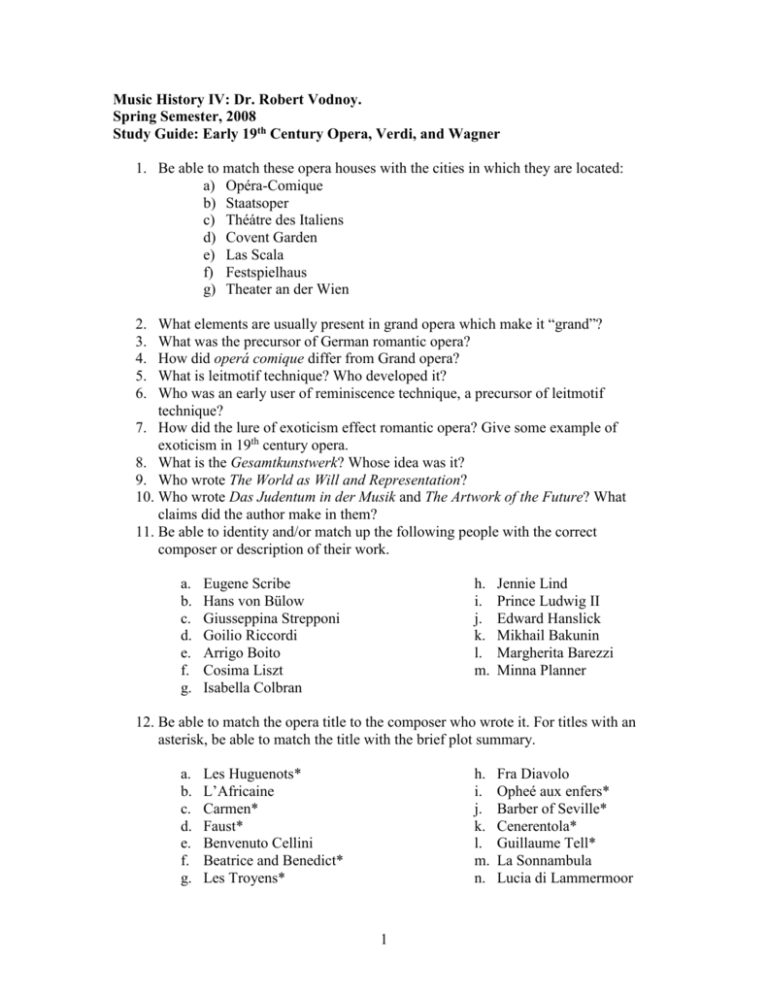
Music History IV: Dr. Robert Vodnoy. Spring Semester, 2008 Study Guide: Early 19th Century Opera, Verdi, and Wagner 1. Be able to match these opera houses with the cities in which they are located: a) Opéra-Comique b) Staatsoper c) Théátre des Italiens d) Covent Garden e) Las Scala f) Festspielhaus g) Theater an der Wien What elements are usually present in grand opera which make it “grand”? What was the precursor of German romantic opera? How did operá comique differ from Grand opera? What is leitmotif technique? Who developed it? Who was an early user of reminiscence technique, a precursor of leitmotif technique? 7. How did the lure of exoticism effect romantic opera? Give some example of exoticism in 19th century opera. 8. What is the Gesamtkunstwerk? Whose idea was it? 9. Who wrote The World as Will and Representation? 10. Who wrote Das Judentum in der Musik and The Artwork of the Future? What claims did the author make in them? 11. Be able to identity and/or match up the following people with the correct composer or description of their work. 2. 3. 4. 5. 6. a. b. c. d. e. f. g. Eugene Scribe Hans von Bülow Giusseppina Strepponi Goilio Riccordi Arrigo Boito Cosima Liszt Isabella Colbran h. i. j. k. l. m. Jennie Lind Prince Ludwig II Edward Hanslick Mikhail Bakunin Margherita Barezzi Minna Planner 12. Be able to match the opera title to the composer who wrote it. For titles with an asterisk, be able to match the title with the brief plot summary. a. b. c. d. e. f. g. Les Huguenots* L’Africaine Carmen* Faust* Benvenuto Cellini Beatrice and Benedict* Les Troyens* h. i. j. k. l. m. n. 1 Fra Diavolo Opheé aux enfers* Barber of Seville* Cenerentola* Guillaume Tell* La Sonnambula Lucia di Lammermoor o. p. q. r. s. t. u. v. w. x. Der Freischütz* Der Fliegende Holländer* Lohengrin* Tannhäuser Das Reingold* Die Walküre* Siegfried* Götterdämmerung* Tristan und Isolde* Die Meistersinger von Nürnberg* y. Parsifal* z. Nabucco* aa. Macbeth bb. La traviata* cc. Les Véspres siciliennes dd. La forza del destino ee. Rigoletto* ff. Il Trovatore gg. Don Carlo hh. Aida* ii. Otello* jj. Falstaff* 13. Match the following arias or scenes with the opera from which they came: a. Una voce poco fa b. L’Amour est un oiseau rebelle c. Wolf’s Glen scene d. Piagea cantando 14. Name an opera based on the literary work of: a. Victor Hugo b. Alexandre Dumas, fils c. Shakespeare d. Goethe e. Virgil 15. What is a cabaletta? 16. What is a patter aria? 17. How does the “double aria” structure work in Rossini’s and Verdi’s operas? 18. What is the bel canto style? 19. Match the number with the correct answer: 2, 13, 26, 39, 70 ___ number of wives which both Verdi and Wagner had ___ number of operas composed by Rossini ___ number of operas composed by Wagner ___ number operas composed by Verdi ___ number of operas composed by Donizetti Questions 19-21 may call for a short answer, or may be a long paragraph with multiple fill-in-the-blank opportunities. 20. Know the basic facts of Rossini’s life, including his family background, early successes, who he married, what theater he managed, and possible reasons as to why he stopped writing opera around 1828. 21. Know the basic facts of Verdi’s life, including his family background, where he was born, his early patrons, the circumstances surrounding his first marriage and second marriage, early successes, personal tragedies, the basic periods into which 2 his creative life can be divided, important operas from each period, his political activity, etc. 22. What does Viva VERDI mean? 23. Know the basic facts of Wagner’s life, including his family background, where he was born, his first and second marriage, his patrons, his political activity, the basic periods into which his creative life can be divided, important operas from each period, his conduct with regard to marriage and money, his attitudes toward Jews, etc. 24. What was the Cecilian movement? How did it effect romantic composition of liturgical music? 25. What work by Beethoven was the model for the large-scale liturgical works of the later 19th century? 26. What are the names of the two large-scale religious works composed by Berlioz? For type of event were they composed? 27. What was the name of the German symphonist who was the organist at Linz and who composed numerous masses and motets? 28. Rossini used an operatic style in his ___________________ which was condemned by Pope Pius ___ in _____________________ of 1903. 29. Verdi composed a Requiem in memory of __________________________, a famous Italian author. 30. What innovations did Wagner incorporate into the design of the Festival House at Bayreuth? 31. What are the differences between a Wagner and a Verdi libretto? 32. What was Verdi’s opinion of Shakespeare? 33. Which Verdi operas are based on Shakespeare plays? There will be listening questions on this test. Take home essay question: Compare and contrast Verdi’s and Wagner’s impact on 19th century opera. Consider their continuation of their respective national styles, their innovations, and their political involvement. Consider also their choices of subject matter. 3
